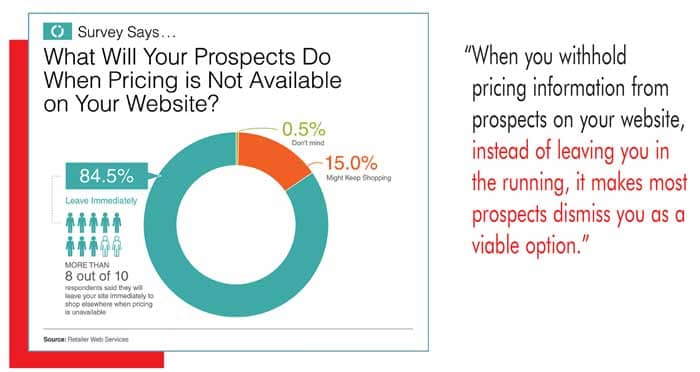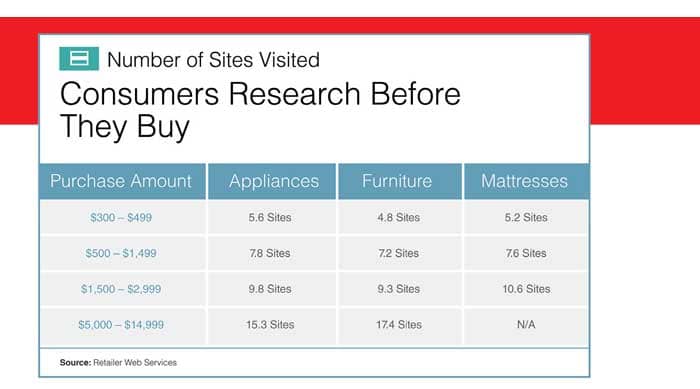This is the second of a two-part series on the results of a nationwide survey to understand today’s U.S. consumer—specifically, their shopping behaviors and purchasing patterns of durable goods for the home such as furniture. In our March/April issue, we discussed a common misconception among independent furniture retailers: If your store is located in a small town, it’s easy to assume everyone knows your business. Nearly 1,800 respondents challenged this conventional wisdom; the results show if you’re an independent durable goods retailer in a small market, most of your prospects don’t know who you are. Here, we look at another all-to-common misunderstanding among independent retailers: to avoid publishing pricing online.
To publish pricing online or not to publish pricing online—it’s one of the most hotly debated discussion points when we talk with independent retailers. Whether we’re at trade shows, town halls or through our own small business, my brother Jim and I have spent countless hours coaching retailers on why they can’t afford not to be transparent with their pricing.
Understandably, the internet can be a double-edged sword for the independent retailer. Nine times out of 10, consumers go to the internet first to research products and decide where to shop. So a website that ranks highly on leading search engines can help to neutralize some of the sophisticated marketing efforts by the national chains. But that’s not enough.
Just how many sites does the consumer research before they buy? Depending on the durable goods product and price range, our survey turned up some fascinating results. As conventional wisdom would have it, the more a consumer expects to spend, the more research they’ll conduct to fully understand their options. What was surprising, however, was the sheer number of sites consumers anticipate browsing!
For example, if consumers expect to spend $300 to $500 on furniture, they anticipate visiting an average of four to seven sites to learn about and compare their options. But if they expect to spend $5,000 or more on a new sofa or other furniture, they plan to visit upwards of 17 websites—that’s a lot of online competition for retailers!

Knowing your prospects will be conducting such a large amount of competitive research means your website will be viewed and quickly judged against four to 17 others, on average. To compete and remain in the running, it goes without saying your site must compare favorably to the other sites your prospects are viewing. While there are many characteristics that go into the evaluation of an effective website (with many of them considered subjective), for the purposes of this article, let’s look at it from the customer’s perspective: What do they expect when they visit a furniture (or other durable goods) store’s website?
What do your online customers really expect?
In our national survey, we asked consumers what mattered most to them when visiting a retail website. Almost 100 percent of respondents said the single most important variable in a quality website was their desire for comprehensive product data. As part of that data, nearly 85 percent cared a great deal about sites showing product pricing—though they also indicated that price isn’t the only factor that’s important in their decision-making process. This runs counter to retailers’ mis-perception—and worry—that prospects will eliminate their business from consideration if their prices are higher than their competitors. Here are some other common beliefs by retailers as it relates to putting their prices online:
- Some retailers assume withholding online prices will compel customers to visit their brick-and-mortar store, increasing their chance of closing the sale.
- Some worry their competition will use pricing information against them.
- For many, setting prices and keeping them up to date is hard enough—it’s a lot easier to simply not include them on their site.
No doubt, there is persuasive logic at the heart of these arguments. But despite these reasonable assumptions, online consumer behavior shows nearly the opposite: when you withhold pricing information from prospects on your website, instead of leaving you in the running, it makes most prospects dismiss you as a viable option. Instead of luring more curious prospects to your stores to learn pricing, withholding pricing discourages potential prospects from trusting you enough to visit your physical locations.
On the topic of building trust with consumers, this could make for its own series of articles. But suffice to say, the evolution of the digital age we’re living in has put “trust” at a premium with transparency as something consumers have come to expect.
Speaking of consumer expectations, how do they feel when a site they’re shopping on does not display prices? The majority of respondents, 85 percent, said they would leave the site and go to a competitor’s site that did list prices. What about the remaining 15 percent? Though they might stay on the site, they would be frustrated that the company hadn’t shared pricing details. So if they’re not leaving your site immediately, you’re leaving them with a feeling of frustration. And let’s not forget about those four to 17 other sites that are a click or tap away.

Meet your online prospective customers
Our research dug deeper into the demographics of our survey respondents. When asked the same question, “How important is pricing on a retailer’s website?” and spliced the data by age, location (population size) and income. Simply put, the grand majority of site visitors leave a site that does not include product pricing no matter where they live, how much money they make or how old they are.
If the data doesn’t sway you on this issue, perhaps the voluntary comments of consumers across the country will:
“I never trust a site that does not display prices.” – 61-year-old woman, Memphis, TN
- “I find it shady that a retailer would not disclose prices.” – 29-year-old woman, Elgin, IL.
- “…I find that a little sketchy if a seller doesn’t display their prices… what are they hiding?” – 23-year-old man, Russellville, AR
- “No prices, no shoppy.” – 71-year-old man, Whittier, CA
- “I need to know the prices to make a decision. I would assume everything is priced too high.” – 37-year-old woman, Monticello, IN
Might your prospects see a higher price on your site and leave for a competitor? Possibly. But without prices, they will almost certainly leave, nine out of 10 times. By not showing prices, your prospects will make the assumption you have something to hide or they can’t afford to shop in your store. Not to mention you can’t put a price tag on losing the consumer trust you have worked so hard to gain.
What this means for your business (and ours)
While hiding prices may make sense from the retailer’s perspective, the situation is entirely different from the consumer’s perspective. Case in point, 85 percent of our survey respondents told us pricing information is a necessity to keep them on a website. And the 15 percent that might stay without it report they have lost trust in the retailer.
Losing 85 percent of your audience is clearly unacceptable, as is angering or alienating the few that do remain. Showing pricing on your website is absolutely essential to the success of your website and your business.
If any of this information feels like a bitter pill to swallow, you’re not alone. When we first read the results, we were not only surprised by the numbers and strength of consumer sentiment, we found ourselves with egg on our face. You see, our own website didn’t clearly state the prices of our products and services… because we shared the same concerns mentioned earlier by our retailer clients.
But upon close review of the survey feedback, we decided to take our own medicine: we now publish our own pricing right on our website for our customers, prospects and competitors to see. It wasn’t a bitter pill after all. Our business has only grown because of it.
About Jennie Gilbert: Jennie Gilbert is the Chief Operating Officer of Retailer Web Services, a Scottsdale, Ariz.-based company whose mission is to help independent retailers realize their dreams through the promise of technology. Jennie is a frequent speaker at durable goods retail conferences and the co-author of RE:THiNK: 11 surprising things you should do now to win retail customers in the digital age (Retailer Web Services, 2015), available on Amazon and at www.retailerwebservices.com.
Furniture World is the oldest, continuously published trade publication in the United States. It is published for the benefit of furniture retail executives. Print circulation of 20,000 is directed primarily to furniture retailers in the US and Canada. In 1970, the magazine established and endowed the Bernice Bienenstock Furniture Library (www.furniturelibrary.com) in High Point, NC, now a public foundation containing more than 5,000 books on furniture and design dating from 1620. For more information contact editor@furninfo.com.